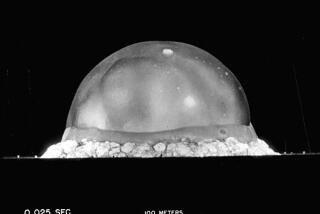Harrison Brown, Atomic Scientist, Dies
- Share via
Harrison Brown, who found ways to separate plutonium for the world’s first atomic weapons and then spent the rest of his years urging the abolition of those deadly devices, is dead.
The prolific author, speaker and teacher was 69 and died of a lung ailment Monday in Albuquerque, N.M.
Trained as a chemist, Brown did undergraduate work at the University of California, Berkeley, and then earned a doctorate at Johns Hopkins University in Baltimore. The subject of his thesis, thermal diffusion of argon and construction of a spectrometer for isotope analysis, made him an ideal candidate for the Manhattan Project, where the first atomic bomb was developed.
Changed Postwar View
He joined the project first at the University of Chicago and later at Clinton Engineer Works in Oak Ridge, Tenn., where he devised ways to produce plutonium.
But soon after the two atomic bombs that were exploded over Hiroshima and Nagasaki ended World War II, Brown joined the Emergency Committee of Atomic Scientists to prevent the further development and spread of atomic devices. Its chairman was Dr. Albert Einstein and Brown became executive vice chairman.
He maintained his anti-nuclear posture for the rest of his life and at his death was editor in chief of the Bulletin of the Atomic Scientists, a publication produced by many who had helped develop nuclear bombs but now are adamant in their opposition to them.
In the meantime, Brown became a copious and noted author. A report, “Elements in Meteorites and the Earth’s Origin,” was judged the most outstanding contribution in that field in 1947 by the American Assn. for the Advancement of Science, and his work and travels brought forth “The Challenge of Man’s Future,” a 1954 book that examined the adequacy of the earth’s resources in a time of burgeoning population growth.
In 1951 he moved to Southern California and joined the faculty at Caltech as a professor of geochemistry, a position he held until 1977.
Adviser to Candidates
From 1962 to 1974 he also was foreign secretary of the National Academy of Sciences in Washington while publishing three more books on humanity’s future: “Must Destruction Be Our Destiny?” “The Next Hundred Years” and “The Human Future Revisited.”
He served as a science adviser to the presidential campaigns of Adlai E. Stevenson and Robert F. Kennedy, was the first U.S. representative to the governing council of the International Institute for Applied Systems Analysis in Vienna and was a member of the U.S. delegation to the first International Atoms for Peace Conference in 1955.
He also was the founding director of the East-West Resource Systems Center in Hawaii, part of his ongoing concern for interdisciplinary approaches to world problems. He later moved to Albuquerque.
Brown is survived by his wife, Theresa, and a son by a previous marriage.






